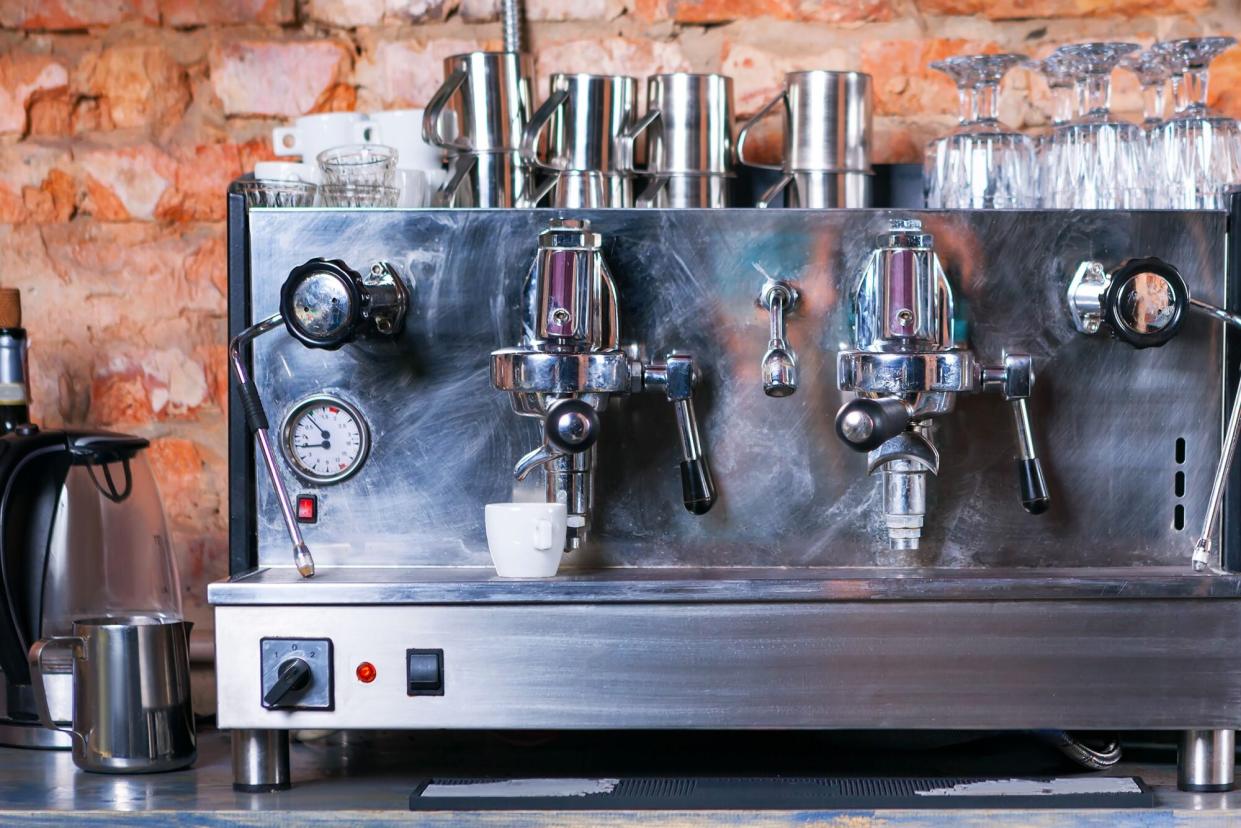Farewell to the Massive Espresso Machine

Lucky Raccoon / Shutterstock
Since the coffee boom of the mid-90s, the giant, awe-inspiring espresso machine –– usually in a bold red or chrome with vintage typography –– has been a fixture in any American coffee shop worth its muster. But in recent years, something different is creeping into the cooler-than-cool coffee shops and bakeries of the San Francisco, New York City, Los Angeles, and more: minimalist, sleek, and almost invisible machines built right into countertops, with the real engineering hidden under the counter and only a smooth spout visible to guests.
Under-the-counter machines are undeniably beautiful, almost erotic in a way that's both pleasing and alarming. (See this photo of dismembered machine bodies, reminiscent of Marcel Duchamp's entangled, abstracted figures.) At La Cabra in New York City's East Village, the bar counter is adorned with Modbar Espresso AV's in a black finish, complementing the shop's chic interior. Mansión Society in Indianapolis uses a custom AV in a bronze patina, while Urban Grounds in Ozark, MO has a Mavam Three Group in a deep green.
La Cabra Manager Ian Walla had a hand in picking the machines when building out the shop in New York City. "I want the machine to work and to make excellent coffee consistently, but once that's done, I think we're only getting started," he says. The tipping point was aesthetic: an under-the-counter machine like the Modbar blends in. "The goal for us really would be just not to see it at all," he says.
It's a big shift from the behemoths with which baristas usually contend and which separate themselves from the customer — and a departure from the other of-the-moment trend: Blank Street Coffee, the venture-funded chain that uses the nearly 360-pound Eversys ShotMaster Pro, according to a New York Times report.
"The real goal is to connect with the person on the other side of the counter," Walla says. "We're really just removing any barriers that we can between the barista and the guests and getting them as close as they can to a quality connection there."
In the age of so-called Amazonification, where consumers are increasingly removed from their services — a Doordash driver hands you food from a restaurant you don't set foot in, cycling classes are taught by a remote teacher streamed into your house, and even therapy can be acquired through an app — it's almost an anachronism to see an emphasis on connection in the context of a coffee shop.
For baristas, however, the connection can come with baggage. Fruitful interactions with regulars or charming guests who leave ample tips are mixed in with guests who might be abusive or flirtatious, or who simply linger too long while baristas are trying to make it through their orders. Still, Walla says, the minimalist setup ultimately pays off. "There are times where it would be really nice to hide away behind a classical espresso machine, but that's really not what we're after. We're not trying to hide away. We're really trying to connect."
While these machines illuminate the person making your coffee, they also obscure the exertion behind making a cup of it, as their slim profile makes it difficult to hide the physical evidence (and inevitable mess) of making a cortado. "Behind the scenes at kitchens and bars is a lot uglier and a lot more messy than it might seem on the guest side, and working with machines like this, you don't have that option [of making a mess]," Walla says.
Hiding the labor while simultaneously spotlighting the worker brings up questions about coffee as a consumer good, and what drinkers really crave from the experience.
Alicia Kennedy, a food and drinks writer based in San Juan, Puerto Rico who has written extensively about food trends and labor, points out that our obsession with the minimalist machine isn't coming from places where the labor of coffee-growing is happening. You won't see machines like this in San Juan, for example, in a country with a once-booming arabica export industry diminished by colonialism. Under-the-counter machines can have the effect of minimizing the large-scale labor effort that goes into coffee: the backbreaking, skilled work of agriculture; the global export; the dexterity and expertise of a barista.
Shrinking espresso machines also signal something specific to the consumer: ease. "It's leisure for the person going, and it's about the appearance of leisure for the person [making the coffee] as well," Kennedy says. She points to inflation and the general unrest about money that's preoccupying much of the world: a recession looms, gas prices only recently started coming down, and food prices are skyrocketing. There is — both online and in coffee shops — a sense that the world is extremely hard right now.
It tracks that consumers are looking for ease, but perhaps even more so, they're looking for care. With the barrier between the barista and the consumer physically down, a buyer can have an intimate that goes beyond the caffeine jolt, and for the right price, pleasure comes easily: effortless, clean, and delivered with the press of a lever into their waiting hand.

